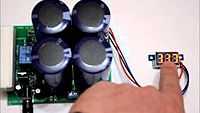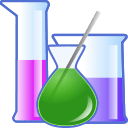Electrochemical capacitors

The image shows a portable super capacitor battery bank. Credit: Mashpedia.
"Electrochemical capacitors, also called supercapacitors, store energy using either
ion adsorption (electrochemical double layer capacitors) or fast surface redox reactions
(pseudo-capacitors)."[1]
Electrochemistry
"The discovery that ion desolvation occurs in pores smaller than the solvated ions has led to higher capacitance for electrochemical double layer capacitors using carbon electrodes with subnanometre pores, and opened the door to designing high-energy density devices using a variety of electrolytes."[1]
Planetary sciences
For a capacitor in an electrical or electronic circuit, charge balance occurs within the capacitor. But, for a planetary capacitor with a variable charge between the spherical plates, the charge between the plates should be negative. The bleed out of positive charges allows the full internal surface of a super capacitor to be used for negative charge only.
Materials
"The chloride permeability of Type V cement concrete specimens was in the range of 2,700 to 3,300 coulombs, putting these concretes in the moderate permeability classification, according to ASTM C1202."[2]
"The electrical resistivity of concrete decreases both due to the presence of moisture and chloride ions."[2]
"AASHTO T277 and ASTM C1202 have specified a rapid test method to rank the chloride penetration resistance of various concretes by applying a potential of 60 V DC to a concrete specimen and measuring the charge passed through the specimen during six hours of testing."[3]
Original research
Hypothesis:
- Supercapacitors may provide a material which can be used to make a charge storage device for up to 1013 coulombs.
See also
References
External links
| Charge ontology |
|---|
| | Lectures | | | | Articles | | | | Courses | | | | Activities | | | | Lessons |
| | | Problem sets | | | | Quizzes | | | | Lists | | | | Projects | | | | Topics |
Astronomy ·
Astrophysics ·
Geophysics ·
Nuclear physics ·
Particle physics ·
Planetary science
|
|
| Chemistry resources |
|---|
| | Lectures | | | | Articles | | | | Courses | | | | Topics |
Acids and bases ·
Advanced Chemistry ·
Analytical Chemistry ·
Astrochemistry ·
Atmospheric chemistry ·
Basic Chemistry ·
Biochemistry ·
Biophysical Chemistry ·
Biological Chemistry ·
Catalysis ·
Chemical engineering ·
Crystal Chemistry ·
Electrochemistry ·
Environmental chemistry ·
Flow chemistry ·
Food chemistry ·
Geochemistry ·
Green chemistry ·
High School Chemistry ·
Historical geology ·
History of chemistry ·
Inorganic Chemistry ·
Marine Chemistry ·
Materials science ·
Medicinal chemistry ·
Mineralogy ·
Mining geology ·
Molecular biology ·
Molecular genetics ·
Nanotechnology ·
Nuclear chemistry ·
Oceanography ·
Organic Chemistry ·
Organometallic chemistry ·
Paleontology ·
Petrochemistry ·
Pharmacology ·
Physical Chemistry ·
Photochemistry ·
Phytochemistry ·
Polymer chemistry ·
Proteomics ·
Quantum chemistry ·
Radiochemistry ·
Soil science ·
Solid-state chemistry ·
Sonochemistry ·
Stratigraphy ·
Supramolecular chemistry ·
Surface chemistry ·
Thermochemistry ·
University Chemistry
| | | Schools |
Agriculture ·
Alternative medicine ·
Business ·
Chemistry ·
Conservation sciences ·
Geology ·
Medicine ·
Pharmacy ·
Physics and Astronomy ·
Veterinary medicine
| | | Activities | | | | Lessons | | | | Original research | | | | Proposal |
| | | History |
| | | Projects | |
|
| Materials science resources |
|---|
| | Activities | | | | Articles | | | | Categories |
Astronomy ·
Astronomy Project ·
Astrophysics ·
Atmospheric science ·
History of science ·
Materials science ·
Metallurgy ·
Physics ·
Sciences ·
Technology
| | | Courses | | | | Glossaries |
| | | Lectures | | | | Lessons |
| | | Original research | | | | Problem sets | | | | Projects | | | | Quizzes | | | | Schools |
Chemistry ·
Construction ·
Engineering ·
Materials Science and Engineering
| | | Topics |
Amateur astronomy ·
Astronomy ·
Astrophysics ·
Electron microscopy ·
Geophysics ·
Materials science ·
Materials science and engineering ·
Metallurgical engineering ·
Nanoscience ·
Nanotechnology
Nuclear physics ·
Particle physics
|
|
| Physics resources |
|---|
| | Activities | | | | Articles | | | | Categories |
Applied mechanics ·
Applied physics ·
Astronomy ·
Astrophysics ·
Atomic, molecular, and optical physics ·
Aviation ·
Avionics ·
Biophysics ·
Cold fusion ·
Computational physics ·
Concepts in physics ·
Condensed matter physics ·
Dimension ·
Dynamics ·
Electricity ·
Electromagnetism ·
Energy ·
Experimental physics ·
Fundamental physics concepts ·
General relativity ·
Gravitation ·
High-energy astrophysics ·
History of physics ·
Materials science ·
Mathematical physics ·
Mathematics ·
Matter ·
Mechanics ·
Biophysics ·
Medical physics ·
Mesoscopic Physics ·
Nanoscience ·
Nanotechnology ·
Optics ·
Physics and Astronomy ·
Physics departments ·
Scientific terminology ·
Technology
| | | Courses | | | | Glossaries | | | | Lectures | | | | Lessons | | | | Lists | | | | Problem sets | | | | Projects | | | | Quizzes | | | | Topics |
Advanced classical mechanics ·
Applied physics ·
Astrophysics ·
Atmospheric physics ·
Atomic Structure and Electromagnetic Radiation ·
Biophysics ·
Classical mechanics ·
Computational physics ·
Condensed matter physics ·
Cosmology ·
General relativity ·
Geophysics ·
Marine physics ·
Mathematical physics ·
Medical physics ·
Nuclear physics ·
Particle physics ·
Photonics ·
Physics ·
Plasma physics ·
Quantum gravity ·
Quantum mechanics ·
Special relativity ·
Statistical mechanics ·
Subdepartments ·
Theoretical physics
|
|
| Repellor vehicle |
|---|
| | Activities | | | | Articles | | | | Courses | | | | History | | | | Lectures | | | | Lessons | | | | Original research | | | | Proposal | | | | Quizzes | | | | Schools |
Aviation ·
Computer science ·
Language and Literature ·
Linguistics ·
Media Studies ·
Technology
| | | Topics | |
|
| Technology resources |
|---|
| | Activities | | | | Articles | | | | Categories |
Astronomy ·
Astronomy Project ·
Astrophysics ·
Atmospheric science ·
History of science ·
Physics and Astronomy ·
Planetary Science ·
Technology
| | | Courses | | | | Glossaries |
| | | Lectures | | | | Lessons |
| | | Lists |
| | | Problem sets | | | | Projects | | | | Quizzes | | | | Schools | | | | Topics |
Amateur astronomy ·
Astronomy ·
Astrophysics ·
Geophysics ·
Nuclear physics ·
Particle physics
|
|
 This is a research project at http://en.wikiversity.org
This is a research project at http://en.wikiversity.org
 |
Educational level: this is a research resource. |
 |
Resource type: this resource is an article. |
 |
Resource type: this resource contains a lecture or lecture notes. |
 |
Subject classification: this is a chemistry resource . |
 |
Subject classification: this is an engineering resource . |
 |
Subject classification: this is a physics resource . |
 |
Subject classification: this is a technology resource . |

![]() This is a research project at http://en.wikiversity.org
This is a research project at http://en.wikiversity.org